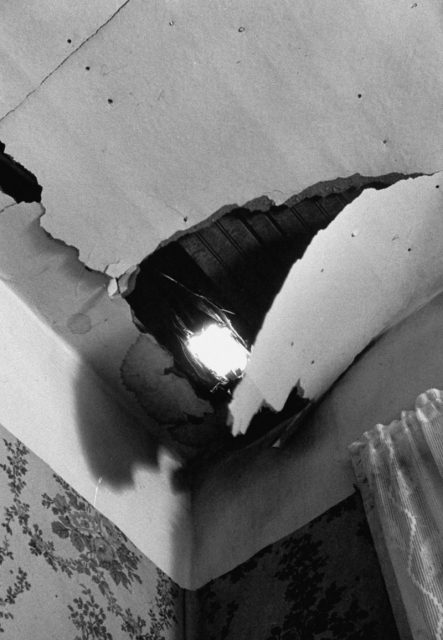A slice of the meteorite, the National Museum of Natural History, the Smithsonian, DC
The Sylacauga meteorite fell on November 30, 1954, at 14:46 local time (18:46 UT) in Oak Grove, Alabama, near Sylacauga. It is commonly called the Hodges meteorite because a fragment of it struck Ann Elizabeth Hodges (1920–1972).
Importance
The Sylacauga meteorite is the first documented extraterrestrial object to have injured a human being in the USA. The grapefruit-sized fragment crashed through the roof of a frame house, bounced off a large wooden console radio, and hit Hodges while she napped on a couch. The 34-year-old woman was badly bruised on one side of her body but able to walk. The event received worldwide publicity.
The Sylacauga meteorite is not the only extraterrestrial object to have struck a human. A manuscript published at Tortona, Italy, in 1677 tells of a Milanese friar who was killed by a meteorite. In 1992 a small meteorite fragment (3 g) hit a young Ugandan boy in Mbale, but it had been slowed down by a tree and did not cause any injury.
Fireball
The meteor made a fireball visible from three states as it streaked through the atmosphere, even though it fell early in the afternoon. There were also indications of an air blast, as witnesses described hearing "explosions or loud booms".
Following events
The United States Air Force sent a helicopter to take the meteorite. Eugene Hodges, the husband of the woman who was struck, hired a lawyer to get it back. The Hodges' landlord, Bertie Guy, also claimed it, wanting to sell it to cover the damage to the house. There were offers of up to $5,000 for the meteorite. By the time it was returned to the Hodgeses, over a year later, public attention had diminished, and they were unable to find a buyer willing to pay.
Ann Hodges was uncomfortable with the public attention and the stress of the dispute over ownership of the meteorite. She donated it to the Alabama Museum of Natural History in 1956.
The day after the fall, local African-American farmer Julius McKinney came upon the second-largest fragment from the same meteorite. An Indianapolis-based lawyer purchased it for the Smithsonian Institution. The McKinney family was able to use the money to purchase a car, new house, and land.
Fragments
Upon the entry within the atmosphere the Sylacauga meteorite fragmented in at least 3 pieces:
Importance
The Sylacauga meteorite is the first documented extraterrestrial object to have injured a human being in the USA. The grapefruit-sized fragment crashed through the roof of a frame house, bounced off a large wooden console radio, and hit Hodges while she napped on a couch. The 34-year-old woman was badly bruised on one side of her body but able to walk. The event received worldwide publicity.
The Sylacauga meteorite is not the only extraterrestrial object to have struck a human. A manuscript published at Tortona, Italy, in 1677 tells of a Milanese friar who was killed by a meteorite. In 1992 a small meteorite fragment (3 g) hit a young Ugandan boy in Mbale, but it had been slowed down by a tree and did not cause any injury.
Fireball
The meteor made a fireball visible from three states as it streaked through the atmosphere, even though it fell early in the afternoon. There were also indications of an air blast, as witnesses described hearing "explosions or loud booms".
Following events
The United States Air Force sent a helicopter to take the meteorite. Eugene Hodges, the husband of the woman who was struck, hired a lawyer to get it back. The Hodges' landlord, Bertie Guy, also claimed it, wanting to sell it to cover the damage to the house. There were offers of up to $5,000 for the meteorite. By the time it was returned to the Hodgeses, over a year later, public attention had diminished, and they were unable to find a buyer willing to pay.
Ann Hodges was uncomfortable with the public attention and the stress of the dispute over ownership of the meteorite. She donated it to the Alabama Museum of Natural History in 1956.
The day after the fall, local African-American farmer Julius McKinney came upon the second-largest fragment from the same meteorite. An Indianapolis-based lawyer purchased it for the Smithsonian Institution. The McKinney family was able to use the money to purchase a car, new house, and land.
Fragments
Upon the entry within the atmosphere the Sylacauga meteorite fragmented in at least 3 pieces:
- The Hodges fragment (3.86 kilograms - 33°11′18.1″N 86°17′40.2″W) struck Ann Elizabeth Hodges.
- The McKinney fragment (1.68 kilograms - 33°13′08.4″N 86°17′20.7″W) was found the next day December 1, 1954 by Julius Kempis McKinney, an African-American farmer, who sold the meteorite fragment he found to purchase a house and more land.
- A third fragment is believed to have impacted somewhere near Childersburg (a few km north-west of Oak Grove).
Classification
The Sylacauga meteorite is classified as an ordinary chondrite of H4 group.
Orbit
The meteoroid came in on the sunward side of the Earth, so when it hit it had passed the perihelion and was travelling outward from the Sun. Considering the orbit estimations, the best candidate as parent body is 1685 Toro.
in Wikipédia
Ed Howard, then Sylacauga mayor,
Ann Hodges and then Sylacauga Police Chief W.D. Ashcraft pose with a
meteorite underneath the point where it crashed through Hodges' house in
1954
Moody Jacobs shows a giant bruise on the side and hip of his patient, Ann Hodges, in 1954, after she was struck by a meteorite
Interior view of a hole in the ceiling of the rental home where Ann Elizabeth Hodges and her husband lived, through which she was struck by a falling meteorite, Sylacauga, Alabama
Interior view of a hole in the ceiling of the rental home where Ann Elizabeth Hodges and her husband lived, through which she was struck by a falling meteorite, Sylacauga, Alabama





Sem comentários:
Enviar um comentário